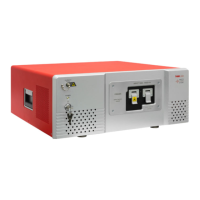Optical Spectrum Analyzers Chapter 4: Description
Rev D, June 16, 2022 Page 6
Figure 2. Optical Schematic of the Thorlabs Redstone OSA305
Note: In the OSA20xC interferometer design, both retroreflectors are attached to a common platform that is
moved via a voice-coil motor. This configuration provides an optical delay that is four times the displacement of
the carriage.
4.3. Interferogram Data Acquisition
The OSA20xC instruments use the interference pattern of the HeNe reference laser to clock a 16-bit Analog-
to-Digital Converter (ADC) such that samples are taken at fixed, equidistant optical path length intervals. The
HeNe reference fringe period is digitized, and its frequency is multiplied by a phase locked loop (PLL), which
leads to an extremely fine sampling resolution. Multiple PLL filters enable frequency multiplication settings of
16X, 32X, 64X, or 128X. At the 128X multiplier setting, the data points are acquired approximately every 1 nm
of carriage travel. The multiple PLL filters enable the user to choose system parameters optimized for
measurements that range from high speed, reduced sensitivity, and reduced resolution to lower speed, higher
sensitivity, and higher resolution.
Redstone OSA305 models instead sample the interferogram at a fixed frequency of up to 1 MHz with an 18-bit
ADC while the retroreflector platform moves at a constant speed controlled by a PID loop. The data is resampled
to fit up to 128 data points per reference laser period.
A high-speed USB link transfers the interferograms to the ThorSpectra software, which is highly optimized to
take full advantage of modern multi-core processors, as well as top-performing graphics processing units
(GPUs). The software performs a number of calculations to analyze and condition the input waveform in order
to obtain the highest possible resolution and signal-to-noise ratio (SNR) at the output of the Fast Fourier
transform (FFT).
Very low-noise and low-distortion detector-amplifiers with automatic gain control provide a large dynamic range,
allow optimal use of the ADC, and ensure excellent SNR for up to 10 mW of input power. For low-power signals,
the system can typically detect less than 100 pW from narrowband sources for mid-wavelength models and as
low as femtowatts for short-wavelength models.
4.4. Detector Temperature Mode (OSA203C only)
The OSA203C features a temperature controller for the detector, which can be set to a low or a high
temperature. The detector is cooled in low temperature mode, which leads to reduced thermal noise and thereby

